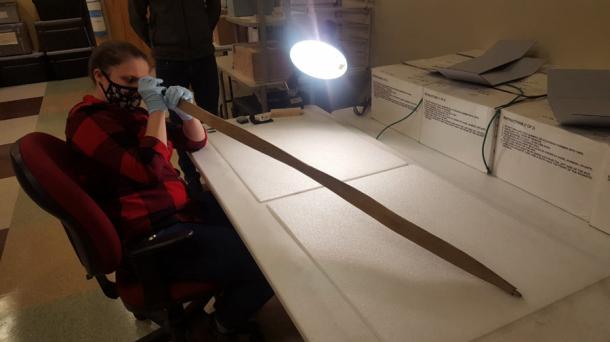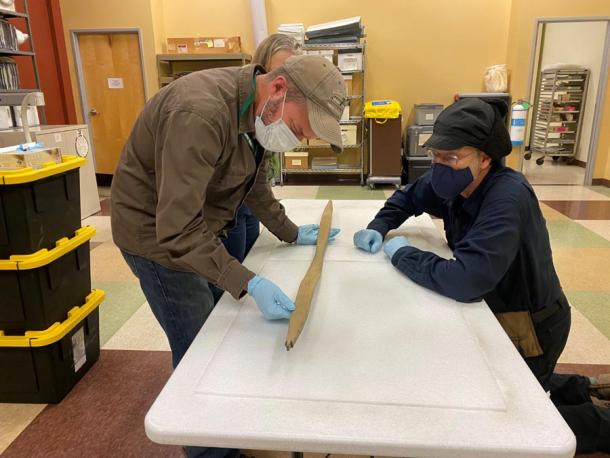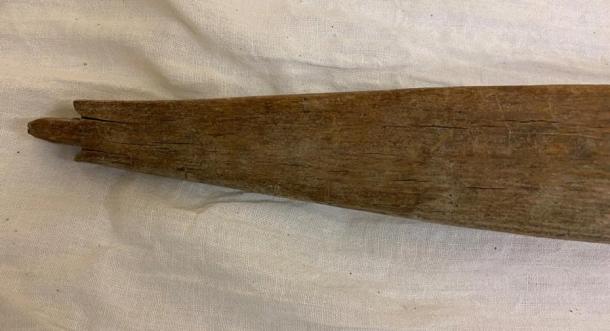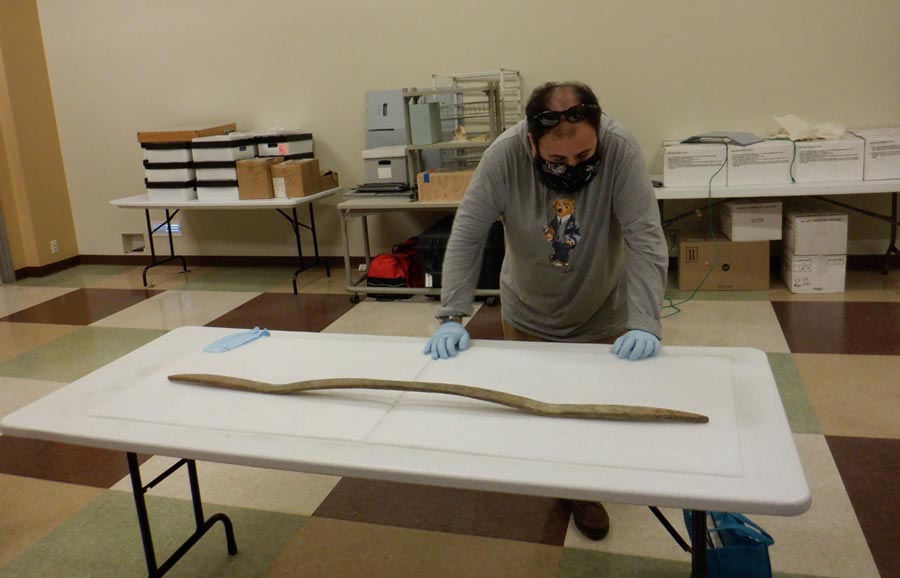‘Perfect’ Wooden Bow Found in Alaska Dated to Late 16th-Century
Lake Clark National Park and Preserve in southwest Alaska is renowned for the fact that no roads lead there, quite literally! Accessible only by boat or floatplanes, this vast expanse of gorgeous biodiversity was proclaimed a national park in 1978. Now, the Park is in the news for the September 2021 discovery of a well-preserved Native American wooden bow, roughly 460 years old and made of spruce, that was found in shallow water, reports Alaska News Source.

USFS wood ID expert Dr. Priscilla Morris examines the wooden bow. (National Park Service/ J. Rogers)
The Ancient Wooden Bow and the Dena'ina Athabascan Culture
National Park Service employees, archaeologist Jason Rogers and Alaska State archaeologist Rich VanderHoek found this bow on Dena'ina Athabascan Culture lands, though preliminary research suggests it may not be connected to the Dena’ina.
Radiocarbon dating indicated that the wooden bow was made between 1506 and 1660, making it up to 460 years old!
- Study of Ancient Teeth Reveals Native American Origins Lie in Siberia
- Ancient Infant DNA Rewrites the History of Humans Entering North America
Dena’ina people, formerly Tanaina in the Russian (as Alaska was part of Russian America till 1867) are a native Alaskan Athabaskan hunter-gatherer culture, who are considered the “original settlers” of southern Alaska. They crossed the Bering Strait an estimated 1,200 – 1,500 years ago.
The Dena’ina culture emphasizes spiritual and symbiotic connections with nature resulting in a harmonious existence. This belief system is prominent in the rich history of the Athabascan region. “We call this ‘K’etniyi’ meaning ‘it’s saying something,” writes Karen Evanhoff, cultural anthropologist for the Lake Clark National Park and Preserve, Alaska.
After extensive consultation with locals, particularly the elders of the Native American communities, the consensus is that the bow likely belongs to either the Yup’ik or Alutiq people, as per a press release by the National Park Service. Measuring 54 inches (137 centimeters) in length, the bow was probably made of spruce and its origins are likely to lie in Western Alaska. The NPS has released eight images of the wooden bow in a virtual gallery.
The Yup’ik lived in Western Alaska and the Alutiq settled in various location on the Alaskan Peninsula. Anthropological studies clearly indicate that the Dena’ina people interacted and traded with numerous other Native Americans, including the Yup’ik tribes from the coastal region of southwest Alaska.
Clearly, interconnectedness between cultures would be one explanation for the potentially Yup’ik wooden bow ending up on Dena’ina territory. “For the Dena’ina people, trading and sharing knowledge with their Yup’ik neighbors as well as other groups such as the Tanana, Tlingit, Ahtna, Deg Hit’an and coastal residents of Prince William Sound and Kodiak was common,” said the NPS statement.

The wooden bow, likely made from spruce, was curved and in “perfect” condition. (National Park Service / K. Myers)
The Best Spruce Trees Result In Almost Perfect Wooden Bows
Dena’ina expert George Alexie recalls his grandfather talking about the wood used to make bows, “My Chuda Alexie (Evan) said that when they would get the material for building the bow, they would go to the mountains. The trees (spruce) up there are a lot stronger because of the wind. The wind blowing the trees makes them bend, so that makes the wood stronger. They used to tell stories about hunting with bow and arrows and times when they used them for wars.”
Dr. Priscilla Morris a wood identification consultant with the U.S. Forest Service, who was brought in to lend her expertise by the NPS, agrees with George Alexie, “After inspecting the artifact, I am leaning towards spruce. Birch is also a suspected species, but I did not see any anatomical characteristics that lead me to believe birch over spruce.”
- Ancient Pipes Reveal What Natives Americans Were Smoking
- Artifacts in Alaska Prove Pre-Columbian America-Europe Trade

The tip of the ancient wooden bow, made of spruce, found in shallow water in Western Alaska, which has been dated to about 460 years of age, and attributed to the Yup’ik or Alutiq people. (National Park Service/K. Myers)
Apart from confirming the species of tree utilized in the making of this amazing wooden bow, it is clear that the cold temperature of the water it was found in, and thereby the lack of oxygen, allowed for the accidental long-term preservation of the wood. Unlike the long classical world history of urban settlement, Alaska is the polar opposite, and almost “empty.” The inhospitable climate, and a lack of road connectivity and development projects means that accidental discoveries are rarely made. Therefore, this find is easily one of the most exciting discoveries from the region in a long, long, while.
Top image: The distinctive double bend of what is being called a “perfect” wooden bow, made from spruce by a Native American tribe from southwestern Alaska, USA but found on Athabascan Dena’ina culture land. Source: National Park Service / J. Rogers
By Sahir Pandey
References
Sentner, K. 2022. 460-Year-Old Hunting Bow Discovered Underwater in Alaska’s Lake Clark National Park. Available at: https://www.outdoorlife.com/hunting/hunting-bow-artifact-alaska/
Sowl, E. 2022. Telling Alaska’s Story: Unearthing the mystery of a hunting bow in Lake Clark National Park. Available at: https://www.alaskasnewssource.com/2022/03/08/telling-alaskas-story-unearthing-mystery-hunting-bow-lake-clark-national-park/




















Comments
Good article, always something interesting found everyday
What a great find. Very interesting. Thanks for the article.